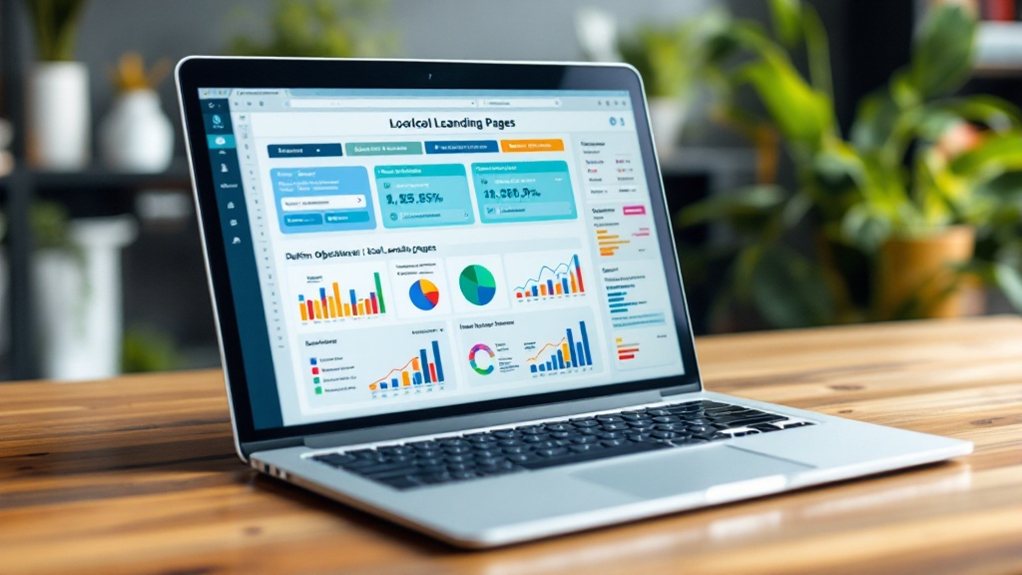To optimize your local landing pages through A/B testing, first establish clear objectives and hypotheses. Test key elements like content structure, CTA design, and localized visuals. Utilize traffic splitting techniques for fair comparisons, and explore advanced methods like multivariate testing. Track relevant metrics like conversion rate and bounce rate. By implementing these strategies, you'll be able to make data-driven decisions that drive more qualified traffic and boost engagement. If you'd like to dive deeper into these tactics, keep reading.
Defining Objectives and Hypotheses

When embarking on A/B testing for your local landing pages, you'll need to clearly define your objectives and hypotheses. The primary goal is to increase website traffic from local searches by improving elements like headlines and CTAs. Conversion rate enhancement should focus on actions such as form submissions or in-store visits. Engagement metrics like time on page and bounce rate can assess user interest. Mobile optimization is crucial, as most local searches occur on mobile. Ensure statistical significance with a minimum of 1,000 visitors per variation. Align your hypotheses with expected user behavior, such as form placement, layout changes, color schemes, and CTA phrasing.
Selecting Key Elements for Testing

To effectively optimize your local landing pages, you'll want to carefully select the key elements to test. This includes analyzing your content structure, CTAs and buttons, headings and titles, and media and visuals. Start by evaluating your text-heavy vs. visual-content layout, positioning of testimonials, and use of interactive elements. Then, test your CTA placement, button design, and wording. Examine your heading styles, keyword usage, and title approaches. Finally, consider the types of images, videos, and other visuals you employ. A/B testing is a crucial strategy for comparing different versions of these elements on your local landing pages. Optimizing these local optimization elements, such as geo-modified keywords and structured data, can also significantly impact your performance. By methodically testing these crucial areas, you'll uncover valuable insights to refine your local landing pages.
Implementing Traffic Splitting Techniques

How do you effectively implement traffic splitting techniques for your A/B testing on local landing pages? Equal traffic distribution is crucial for fair comparisons, but unequal methods can target user segments more strategically. Employ custom proportions to focus traffic on new variants for faster insights. Ensure large sample sizes for accurate results, and leverage weight-based distribution tools. Marked up the site with the most valuable structured data can facilitate complex traffic splitting, with features like user binding and real-time analytics. Optimize test duration and continuously monitor to adjust strategies. Targeted distribution enhances relevance and supports better budget allocation, informed by user behavior and conversion data.
Exploring Alternative Testing Methods
While A/B testing is a great starting point, you may want to consider more advanced techniques like multivariate testing. This allows you to test multiple elements simultaneously, revealing the most effective combination for your local landing pages. Multivariate testing can provide deeper insights into the interplay between different factors, helping you optimize your pages more effectively. Additionally, split URL testing can be a powerful tool, allowing you to test completely different page designs side-by-side.
Multivariate Testing Advantages
One of the primary advantages of multivariate testing is the comprehensive analysis it provides. By testing multiple variables simultaneously, you can gain a deeper understanding of how different elements on your landing page interact. This is more efficient than running sequential A/B tests, and it can uncover significant improvements you might have missed otherwise. Multivariate testing offers:
- Detailed insights into element interactions
- Higher improvement potential through wide-ranging variations
- Deep optimization beyond surface-level changes
- Faster results compared to multiple A/B tests
This approach is particularly valuable for complex web pages with many interactive elements, as it helps you make data-driven decisions to enhance the user experience and boost conversions.
A/B/C Approach Benefits
Beyond the advantages of multivariate testing, the A/B/C approach offers several compelling benefits for your landing page optimization efforts. It boosts efficiency by allowing you to test multiple variations simultaneously, saving time compared to sequential A/B tests. With three variants, you'll gain more comprehensive insights into user preferences, leading to higher confidence in your results. This data-driven decision-making reduces reliance on intuition, empowering you to make informed choices across various elements like headlines, visuals, and calls-to-action. A/B/C testing allows for testing three variants simultaneously, providing more data points for comparison. While the analysis may be more complex, the A/B/C strategy's broader applicability can significantly enhance your landing page performance.
Identifying Relevant Performance Metrics
Relevant performance metrics are crucial for evaluating the success of your local landing pages. Conversion rate, click-through rate (CTR), bounce rate, and time on page provide insights into user actions and engagement. Additionally, tracking traffic volume, pages per session, average session duration, new vs. returning users, and device segmentation can reveal user behavior patterns. A/B testing can increase sales by 49% on average. To monitor your local SEO performance, utilize tools like Google Analytics, Google Business Profile Insights, BrightLocal, SEMrush, and Google Optimize. Remember to set clear goals, confirm statistical significance, iterate testing, monitor indirect effects, and leverage user segmentation for actionable insights that drive continuous optimization.
Optimizing Headline Variations
As a critical element of your local landing pages, optimizing headline variations through A/B testing can have a significant impact on user engagement and conversions. Experiment with font sizes, styles, placement, and tone to determine the most effective approach. Remember, the right keywords and messaging can also boost your SEO. A/B testing helps optimize landing pages for improved conversion rates, user engagement, and other key metrics.
| Headline Variation Factors | |
|---|---|
| Font Size and Style | Test different options to maximize attention. |
| Headline Position | Evaluate top, bottom, left, or right placement. |
| Emphasis and Keywords | Highlight key messages and target high-performing keywords. |
| Length and Clarity | Find the sweet spot between concision and detail. |
| Language and Tone | Experiment with formal, informal, serious, or playful tones. |
Continuously optimize your headlines using data-driven tests to improve performance and drive results.
Experimenting With Call-To-Action Designs
Experimenting with the design and placement of call-to-action (CTA) buttons can significantly boost user engagement and conversions on your local landing pages. By A/B testing various CTA elements, you can identify the most effective strategies for your audience. Analyzing user interaction data is vital in strategizing effective CTA placements. Consider these approaches:
- Leverage interactive design: Incorporate animations or hover effects to make your CTAs more engaging.
- Optimize color and contrast: Use contrasting colors to make your CTAs stand out and grab attention.
- Test different locations: Experiment with placing CTAs above or below the fold to determine the optimal position.
- Craft compelling copy: Use action-oriented language and emphasize the benefits to encourage immediate action.
Continuous experimentation and analysis are key to unlocking the full potential of your CTA design.
Leveraging Localized Visual Elements
Leveraging localized visual elements on your local landing pages can be a powerful strategy to capture your audience's attention and foster a stronger connection with your brand. Using images and videos featuring local landmarks, events, or customers can increase user engagement, improve SEO, and boost conversion rates. Test different location-specific visuals to see which perform best. Incorporate dynamic content that adjusts based on the user's location. Embed interactive maps, photo galleries, and QR codes to further integrate local elements. Analyzing metrics like bounce rate and time on page can optimize your visuals. By tailoring your multimedia to your local audience, you can create a more compelling and relevant experience.
Ensuring Responsive and Fast Experiences
Optimizing your mobile layouts and streamlining your page speed are critical for delivering responsive and fast experiences. A/B testing can help you identify the best-performing designs and assess the impact of speed enhancements. By focusing on these areas, you can ensure your local landing pages provide an exceptional user experience that drives conversions.
Optimize Mobile Layouts
As a business owner, ensuring your mobile landing pages are optimized for responsive design and fast loading times is crucial. Follow these best practices to enhance the user experience on smaller screens:
- Leverage white space effectively to highlight key information and separate elements clearly.
- Choose high-contrast colors that provide clear distinction between background and text.
- Implement clear, actionable calls-to-action that are prominent on mobile devices.
- Continuously refine your layout based on A/B testing and user feedback to identify the most user-friendly design.
Streamline Page Speed
When it comes to streamlining page speed, you'll want to tackle the technical foundations first. Minify your CSS and JavaScript files to reduce file sizes and improve load times. Measure your page speed using metrics like Largest Contentful Paint (LCP) to ensure your main content loads quickly. Utilize content delivery networks (CDNs) to serve content from locations closer to your users, enhancing their experience. Regularly test your site's performance and identify areas needing optimization. Use lightweight code to minimize bandwidth usage and improve load times.
Implement browser and server caching to reduce repeat loads of static resources. Compress images without compromising quality to reduce file sizes. Load non-essential scripts and stylesheets asynchronously to prevent blocking initial page rendering. Optimize your server response time through efficient hosting solutions and communication protocols.
Achieving Statistically Significant Results
Why is achieving statistically significant results crucial for A/B testing local landing pages? Without it, you risk drawing inaccurate conclusions that could negatively impact your marketing efforts. To ensure your tests are reliable:
- Aim for a 95% confidence level to separate real differences from chance.
- Run tests for at least two weeks to capture enough data.
- Split traffic evenly to avoid bias.
- Maintain sufficient volume to prevent skewed results.
Resist the temptation to end tests prematurely. Patience and rigorous analysis are essential for making data-driven decisions that improve your local landing pages.
